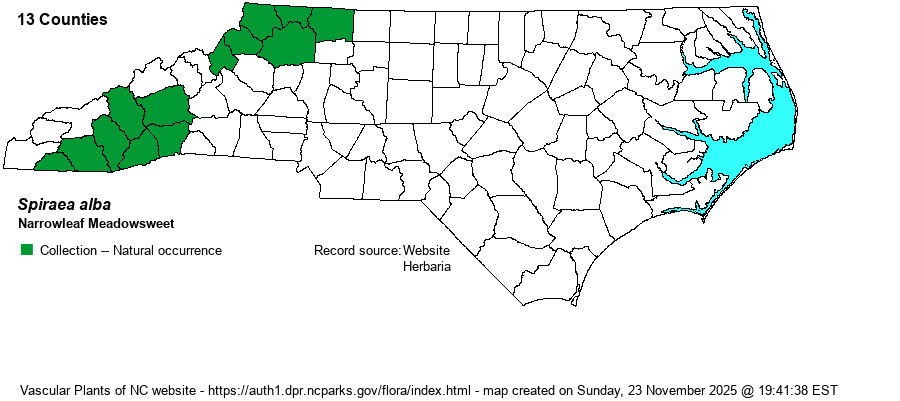| Section 6 » Order Rosales » Family Rosaceae |
Show/Hide Synonym
| taxonName | relationship | relatedTaxonName | relatedTaxonRefText | relComments |
|---|
|
|
|
|
|
|
|
|
|
| Spiraea alba | = | Spiraea alba var. alba | Gleason and Cronquist (1991) | | | Spiraea alba | = | Spiraea alba var. alba | Flora of North America (1993b, 1997, 2000, 2002a, 2002b, 2003a, 2004b, 2005, 2006a, 2006b, 2006c, 2007a, 2009, 2010) | | | Spiraea alba | = | Spiraea alba var. alba | Godfrey and Wooten (1979, 1981) | | | Spiraea alba | = | Spiraea alba var. alba | | | | Spiraea alba | = | Spiraea alba var. alba | | | | Spiraea alba | = | Spiraea alba var. alba | Radford, Ahles, and Bell (1968) | | | Source: Weakley's Flora |
|
| Author | Du Roi | |
| Distribution | Nearly throughout the Mountains; not found in the Piedmont. This species and S. latifolia have only recently been split as full species, and thus old literature reports might not have differentiated between the two. Therefore, the exact montane distribution is not clear, but it does occur from the VA border to the GA border.
This Northern species ranges south through PA to MO, and southward primarily in the Appalachians, to southern NC.
| |
| Abundance | Rare to uncommon; a Watch List species as designated by the NC NHP. Because of the recent separation of the two species, exact abundances of these are not clear, but both seem to be quite scarce and local. | |
| Habitat | It has a fairly restricted habitat – bogs, seepages, wet meadows, and stream banks, mostly in open and rather high-quality habitats. |
| Phenology | Blooms from June to September, and fruits from August to October. | |
| Identification | This is an upright (often stiffy so) deciduous shrub to about 5 feet tall. Both of these two species – Spiraea alba and S. latifolia -- are readily identified only when in bloom (or fruit), as they have a showy panicle of small white flowers terminating the stems. Spiraea alba has hairy or tomentose branches within the inflorescence, as opposed to smooth branches in the inflorescence for S. latifolia. Also, as the common names imply, this meadowsweet has somewhat narrower leaves than does S. latifolia; leaves average 3-5 times longer than wide (versus 2-3 times longer than wide in S. latifolia). | |
| Taxonomic Comments | Until recently it was considered to have two varieties – S. alba var. alba and S. alba var. latifolia. Though most references now recognize both as species, there is still some concern about whether this is a legitimate split, as the ranges are quite similar, and most characters are very similar.
| |
| Other Common Name(s) | White Meadowsweet was the combined name for both species; rarely used include Pale Bridewort and Pipestem | |
| State Rank | S2 | |
| Global Rank | G5 | |
| State Status | W1 | |
| US Status | | |
| USACE-agcp | FACW link |
| USACE-emp | FACW link |

